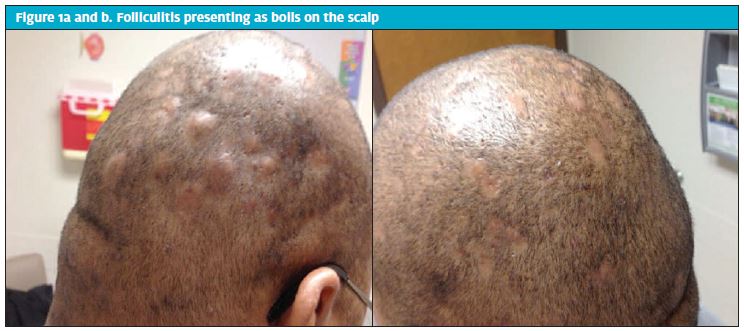Published on
Urgent message: Prompt recognition of dissecting cellulitis is important to help patients receive appropriate treatment and avoid long-term conse – quences such as alopecia.
MOHAMED A FAYED, MD
Introduction
Dissecting cellulitis of the scalp is a chronic skin condition for which patients often present to urgent care providers. Prompt recognition of such cases could have significant potential benefit to patients in ensuring successful treatment and preventing complications.
Case Presentation
A 39-year-old African-American male presented with spreading boils on his scalp. He reported having the boils for about 4 months. He had been seen by an urgent care provider several weeks before, at which time he was given azithromycin, to which his condition did not respond. During his teenage years, the man began shaving his head and also had a history of acne. He was married and denied any other sexual partners or any changes in lifestyle.
Observations and Findings
Physical examination of the patient revealed the following:
BP: 136/94
P: 86
RR: 12
T: 98.6°F
Cardiac evaluation demonstrated a normal heart rate and rhythm. Lung exam showed normal lung sounds. Physical examination revealed multiple nodules and papules on the scalp. Attempts at squeezing some of the lesions resulted in drainage of serous fluid. Patchy alope- cia also was noted on some of the scalp lesions.
Diagnosis and Treatment
The patient had extensive folliculitis on his scalp (Fig- ure 1 a and b). The diagnosis was dissecting cellulitis of the scalp. The patient was prescribed doxycycline and given a referral to a dermatologist.

Discussion
Dissecting cellulitis of the scalp or perifolliculitis abscedens et suffodiens is a rare chronic skin disease affecting the scalp. It is relapsing in nature and typically causes scarring alopecia.
Dissecting cellulitis can occur alone or in conjunction with the other members of the follicular occlusion triad, which includes acne conglobata and hidradenitis suppuritiva.1 This disease affects mainly the African-Ame ican population during the second to fourth decades of life. It disease starts as small follicular lesions but rapidly transforms to pustular and nodular lesions.
In patients with dissecting cellulitis, much of the scalp especially the crown and vertex are covered by boggy or fluctuant nodules. Pressure on a nodule often results in extrusion of pus or serosanguinous material. The condition can wax and wane in severity for many years, but eventually will result in hypertrophic scarring and permanent hair loss. The inflammatory process tends to involve the lower portion of the dermis and the subcutaneous junction, and so the lower portion of terminal follicles is most affected.1 This explains the scarring alopecia when the disease pro- gresses without treatment. The presence of hair follicles appears to be essential for disease progression.
Because treatment of dissecting cellulitis is challenging and usually long, patients with the condition should be educated about the nature of the disease. Dermatology refer- ral is usually necessary unless an urgent care provider is comfortable treating the condition. Medical options include isotretinon, antibiotic therapy, oral zinc sulfate, and tumor necrosis factor-alpha (TFN- ) blocker. Treatment typically is initiated with oral or topical isotretinon, which produces reasonable success.2 Other options include oral antibiotic and oral zinc sulphate. Case reports document success with multiple antibiotic regimens, such as ciprofloxacin 500 mg BID for a few weeks with a slow taper.3 Remission of dissecting cellulitis also has been documented with use of doxycycline for several months, and with rifampin with isotretinon.4,5 Newer options for therapy that have proven successful include infliximab and use of a TFN inhibitor such as adalimumab.6,7
Severe and resistant cases of dissecting cellulitis can be treated with selective follicular destruction, such as with electron beam radiation.8 Complete surgical scalp excision followed by split-thickness grafting also has been documented.9
References
- Sperling LC. Scarring alopecia and the dermatopathologist. J Cutan Pathol. 2001 Aug;28(7):333-342.
- Scerri L, Williams HC, Allen Dissecting cellulitis of the scalp: response to isotretinoin. Br J Dermatol. 1996;134(6):1105-1108.
- Onderdijk AJ, Boer Successful treatment of dissecting cellulitis with ciprofloxacin. Clin Exp Dermatol. 2010n;35(4):440. doi: 10.1111/j. 1365-2230.2009.03514.x. Epub 2009 Sep 15
- Ross EK, Tan E, Shapiro Update on primary cicatricial alopecias. J Am Acad Derma- tol. 2005;53(1):1-37;quiz 38-40.
- Georgala S, Korfitis C, Ioannidou D, et Dissecting cellulitis of the scalp treated with rifampicin and isotretinoin: case reports. Cutis. 2008;82(3):195-198.
- Wollina U, Gemmeke A, Koch Dissecting Cellulitis of the Scalp Responding to Intra- venous Tumor Necrosis Factor-alpha Antagonist. J Clin Aesthet Dermatol. 2012;5(4):36-39.
- Sukhatme SV, Lenzy YM, Gottlieb Refractory dissecting cellulitis of the scalp treated with adalimumab. J Drugs Dermatol. 2008;7(10):981-983.
- Chinnaiyan P, Tena LB, Brenner MJ, Welsh Modern external beam radiation ther- apy for refractory dissecting cellulitis of the scalp. Br J Dermatol. 2005;152(4):777-779.
- Housewright CD, Rensvold E, Tidwell J, Lynch D, Butler Excisional surgery (scalpec- tomy) for dissecting cellulitis of the scalp. Dermatol Surg. 2011;37(8):1189-1191. doi:10.1111/j.1524-4725.2011.02049.x. Epub 2011 Jun 1.
